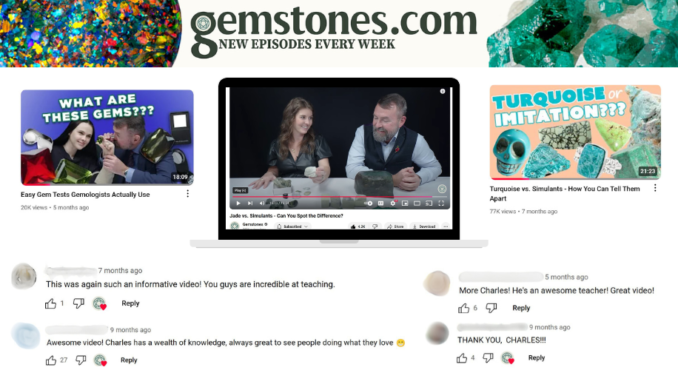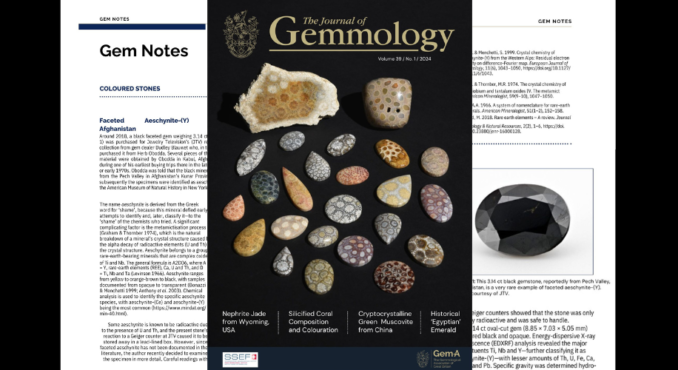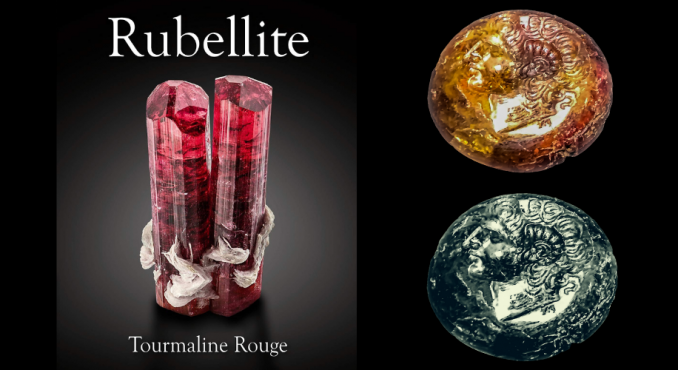Media
Articles, Press Releases, Images and Webinars
Articles, Press Releases, Images and Webinars

It seemed a little crazy that there was nothing in gemmological literature characterizing faceted phenakite from the region formerly known as Volodarsk-Volynski (‘Khoroshiv’ since 2015). This was a little ironic since the region is the type-locality for phenakite. At the behest of the Journal of Gemmology’s editor, Brendan Laurs, I set about rectifying this.
Continue reading “Characterizing Faceted Phenakite, a Gemstone from Ukraine”
During my career, I have spent a lot of my time on education that is focused on an audience either already within the gem and jewellery industry, or those that are making an effort to become a part of it. It is very easy to get pigeon-holed here, however, it is important that every one of us in the industry remember that it took something to capture our own initial interest. That one thing could just be a YouTube video.
Continue reading “Videos Are Introducing More People to the Fascinating World of Gemology”
More than 50 years have passed since the gemstone Aeschynite emerged from Afghanistan. Since then, no further examples have ever come to the market and that makes this a very unique and rare gemstone. It was certainly worth a closer look.
Continue reading “Hot Rocks in a Pig Box”
JTV has focused on building a dedicated resource for the public, and professionals, to learn about gemstones. This information has found its home on the appropriately named gemstones.com website. It was intended to be free of all advertising so as not to distract the reader’s attention from finding and studying the information provided.
Continue reading “Unlocking the Secrets of Gemology – One Article at a Time”
Written for industry specialists, this article challenges the conventional approach to the teaching of Colour Filters, which tends to view them as an entirely separate tool and learning concept. I suggest this could be improved and doing so would empower students with a deeper understanding of the filtering of light, and the wider influence of transitional elements, while also bettering the understanding of the graphic output of spectroscopic data, and the concepts of absorption and emission. Students often struggle to relate what they see through a colour filter with what they see in a graph.
Continue reading “Colour Filters: Useful tools that gemologists should use but often don’t”
My first visit to Hong Kong was in 1997 and I loved it. Over the years it has been home to some amazing gemmologists and when I was working with Gem-A, there was a fantastic team based in a city that has more gemmology schools in a few square miles than the whole of the UK.
In 2020, when I was asked if I could put some thoughts into words for the annual Journal of the Gemmological Association of Hong Kong, I was flattered and used the opportunity to focus and reflect on some of my long-standing beliefs.
Continue reading “Being Proud of Those in the Gemstone Supply Chain”
One of the most important discoveries in the history of diamond mining was that diamonds were found in kimberlite. Until then, the world had obtained diamonds from Golconda and Brazil where they were found in alluvial gravels. The town where this was discovered was called Kimberley in South Africa and in geological terms, Kimberley is the ‘type locality’ of kimberlite. As part of the Gem-A Live series, I was asked to deliver a webinar on the town of Kimberley, discussing the significance of the diamond discoveries not only to the town and to South Africa as a whole, but also on the diamond industry worldwide.
Continue reading “Webinar: 150 Years of Diamond Mining in Kimberley”

Someone well-known to gemmologists, mineralogists and, indeed, anyone with a keen interest in gems, minerals and great photography, is Gloria Staebler.
Through Gloria, I was included in an investigation to verify something she had noticed in the course of her research, and I was proud to be able to contribute. We were asked to verify if the Ashmolean Museum in Oxford had correctly identified a gemstone carving of Alexander the Great as Tourmaline. In which case it would be the world’s oldest known tourmaline carving, predating that currently believed to be the oldest by 500years.
Continue reading “The Discovery of the Oldest Known Tourmaline Carving”

It is not often that a gemmologist gets to see something from Antarctica, a continent that still enjoys the protection of the 1961 international treaty intended to protect and preserve the untapped uniqueness of the biosphere from the rapacious consumption of mankind. This Gem Note, featured in the Journal of Gemmology, covers an exciting opportunity that presented itself when faceted samples from a research trip to Mount Erebus reached the laboratory. I could get the graphs and numbers from the battery of laboratory equipment, but it was Nathan Renfro’s brilliant photomicrography that captured the essence of these samples.
Continue reading “Rare Opportunity: Gemstones from Antarctica”

This image appears a simple one, two men showing me what they had found that morning on their ‘dig’ in Elahara, Sri Lanka. This was a field trip that we ran in conjunction with the National Association of Jewellers and took a mixture of gemmologists and jewellers to this incredible island nation to discover just what made it so unique and special. Beyond the image is a bigger story. These men are farmers for half the year and then their farmland becomes a mine-site.
Continue reading “Sustainability in Artisanal Sapphire Mining”